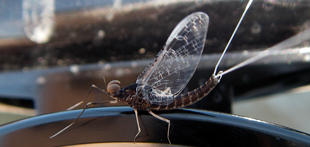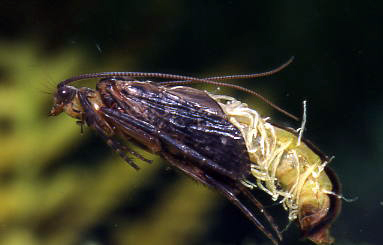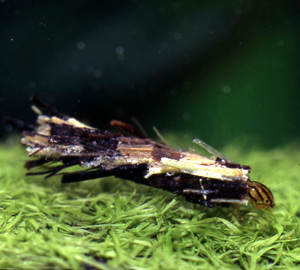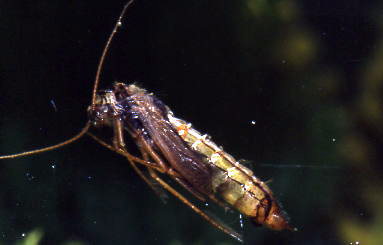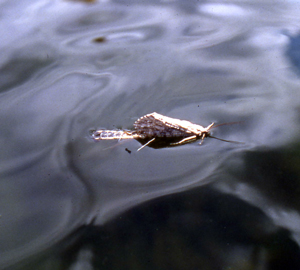|
|
|
Hatches - Caddisflies - Traveling SedgesFew other insect emergences cause as much excitement within the ranks of both seasoned and beginning fly fishers as that of the Traveling Sedge or Giant Case Maker Caddis. Just the names alone are enough to pique the interest of even the occasional lake fly fisher. Experiencing even one of these legendary emergences is enough to leave the memory permanently etched in your mind. For me, two experiences sum up the effect this insect hatch has on both trout and anglers. Roche Lake, situated about 20 miles southeast of Kamloops, BC is well known for its traveling sedge emergences that occur both during the day and at night. The abundant marl laden shoals provide prime habitat for these juicy morsels of trout food. A friend and I were fishing the lake one late June a number of years ago, waiting in anticipation of an evening hatch. A clear sky and ¾ moon prompted an emergence and soon it was easy to first hear, then see the boiling slashes of the trout as they chased down newly emerged adult caddis as they scampered across the surface film. We hooked, broke off, and eventually landed some very nice rainbows that night as the great dry fly action lasted well past midnight. However, even more astounding was when we went back into the same bay later that same morning we saw a number of very large trout, some in excess of 7 pounds, laying dead, beached along the weedy shoreline. The only explanation for this situation was that these fish had chased the large caddisfly adults right to shore and then could not find their way back to deeper water before drowning from lack of oxygen. A dissection of one of these fish produced a large handful of traveling sedge pupa and adults!
Trout that feed at the surface of a lake or river expose themselves to predators so the reward certainly has to be worth the risk. The Traveling Sedge adult is a big food item, often exceeding well over an inch in length. It is a tempting target to cruising but wary trout. I learned a lot about adult feeding tactics a number of years ago while filming an instructional videotape. We had hiked into a small, marl shoaled lake to film the caddis emergence and fishing tactics. Traveling Sedges began emerging in the early afternoon and the trout were on them. On several successive casts with deer hair adult imitations the trout would boil on the fly but not get hooked on the resulting strike. Slow motion filming of the caddis as it ran across the water, and of the subsequent take, revealed the exact feeding tactics of these trout. The initial boil would drown the adult and a second swirl would see the trout take the subsurface adult. We now started hooking fish on a regular basis by not striking at the first boil and just continuing with a slow pull of the drowned fly which would be taken by the fish on its second pass around. I can assure you that not striking at the first boil is not an easy thing to do!
More About Traveling Sedges
Caddisflies, members of the insect order Trichoptera, are widely distributed in North America with 21 families and over 1,200 species found living in flowing and standing waters. They are an important trout food source primarily because fish are able to feed on all stages of their life cycle; larval, pupal, and adult forms. The easiest way to identify many of the families and individual species of caddisflies is by the materials used to construct the larval cases and the actual design of these cases. The Traveling Sedges or Giant Case Makers belong to the Family Phryganeidae and, as their name implies, these are perhaps the largest of the caddis species present in North America. Larvae can reach in excess of 1-1½ inches long and their cases can be even longer than that. Larval cases are usually constructed using pieces of wood or vegetation laid in a pattern of uniformly spaced rings or in an angled spiral pattern. This distinct case design plus their overall large size make them easy to recognize by both trout and anglers.
Traveling Sedge larvae live amongst the bottom vegetation and organic matter that covers the shoals or shallow water areas of the lake. Larvae can take up to 2 years to mature and during that period they undergo 5 instars or growth stages that are separated by a molting process. During the first 4 instars the larvae are primarily herbivorous, feeding on green algae and plant material. The green plant material also keeps them hidden from predators. The final instar sees the larvae become predaceous and preferred food sources include scuds, mayfly and damselfly nymphs. This carnivorous diet requires the maturing larvae to become more aggressive and active in their feeding behaviour which is why they are occasionally found in the stomachs of trout and other fish species. The transformation or metamorphosis from the last larval instar to the pupal stage occurs within the sealed larval case. It takes between 3-5 weeks, depending on water temperature to complete the process. The fully developed pupa then breaks out of the old larval case and begins a steady but quick swim to the surface of the lake. The pupa have a pair of hind legs that are elongated and feathered to literally propel through the water in 4-6 inch long gliding motions. The pupal ascent could begin in water 20 foot deep so the trip to the surface can take as much as 60 seconds to complete. This is just the start of a very vulnerable journey for this insect. Upon reaching the surface, the adult form breaks through the pupal thorax and crawls out onto the water. Newly emerged adults immediately hold their wings upright, like a mayfly dun, to dry them off, and then quickly fold them tent-like over their backs while running across the surface film for a short distance before becoming airborne. These large, slow fliers are also easy meals for birds and bats. Mating typically occurs in the riparian vegetation and egg laden females return to the water to begin the next generation. Females release strands of eggs by dipping the tip of their abdomen beneath the surface film while running or fluttering across the water. Egg laying often occurs during low light or evening hours.
Pupal Fishing Tactics
Reviewing the life cycle of the Traveling Sedge, one can see that it is most vulnerable to trout predation during the pupal swim and as newly emerged or egg laying adults. While the angler eagerly anticipates dry fly action, the pupal stage attracts the majority of attention by the trout. Feeding on the caddis pupa below the surface is much safer than surface feeding when it comes to avoiding the common predators of trout which include ospreys and loons.
Traveling Sedge pupae swim on a shallow angle upward to the surface of the lake. Trout can intercept these large food items at any depth but often prefer to do so closer to the lake bottom than the surface. It is always wise to first present pupal patterns near the bottom of the shoal and gradually work up through the depth zones. Floating and slow sinking lines are ideal for imitating the pupal swim. The key to successfully fishing the pupa is to ensure your pattern is right on the lake bottom before initiating a retrieve. Floating lines are perfect for fishing water up to about 16 feet in depth. Use a leader at least 25‰ longer than the depth being fished to ensure the fly can reach the bottom. In deeper water switch to a slow or intermediate sinking line and use a countdown to make sure the fly reaches the bottom before starting the retrieve. A quick 4-8 inch long strip retrieve interspersed with regular pauses is a good match to the real movement of this insect life stage. You will quickly find out the preferred feeding depth which often will be a 2-3 feet wide zone in water that could be 12-20 feet in overall depth. Using the floating line and long leader technique makes it possible for the fly to stay in a relatively narrow depth zone while retrieved horizontally through the water column. This is achieved by first allowing the fly to sink to the desired depth and then making several quick strips and then pausing long enough for the fly to sink back down. This is an important technique to learn as it is an effective presentation for many other important stillwater trout food sources. Use the same strip retrieve when using the slow or intermediate sinking line. Make sure to allow the pupal pattern to first sink to the desired depth before initiating the retrieve.
Another effective fly line for this emergence is the Rio Midge Tip, a sink tip with a one meter long clear intermediate tip. The short sinking tip helps keep the leader and fly in a specific depth zone. It is well suited for presenting chironomid pupa, mayfly and damselfly nymphs.
One should have both weighted and un-weighted pupal patterns in the fly box as there will be times when the trout are feeding on the pupa within a couple of feet of the surface of the lake. Trout feeding this high in the water column will sometimes reveal themselves with bulging riseforms where only their backs break through the surface film. In this situation, use a floating line, 12-foot leader and an un-weighted pupal pattern. Allow the fly to sink to the desired depth and begin a slow retrieve of short, 2 to 4 inch slow strips or try wind drifting by casting perpendicular to the direction of the wind and allow the gentle wave action to provide natural undulating action to the fly. The Traveling Sedge pupa is a big food item and the strikes are aggressive so choose adequate tippet strength such as 4X fluorocarbon, as a minimum.
Adult Fishing Tactics
It is pretty safe to say that catching trout on dry flies provides one of the ultimate fly fishing experiences. A good emergence of adults or significant numbers of returning egg laying females will bring the trout up for some surface feeding. Watching a live Traveler Sedge disappear in a swirling boil should be enough reason to give the dry line and floating adult pattern some exercise. The "go to" retrieve to use is a fast, continuous, 2-3 inch strip with the occasional 1-2 second pause. Remember to observe how the real insects are being taken just in case the trout are drowning the fly on the first pass. One can track a particular fish as it takes one adult then moves on to another one. We can anticipate the direction that trout is traveling and cast ahead of it so that an adult pattern can be presented across its field of vision. As soon as the fly hits the water begin the fast strip retrieve. If casting to rising fish with floating patterns results in only limited hook ups, try a pattern that rides lower in the surface film. The fish could be selecting emerging adults versus fully emerged ones. Emergences occurring on windy overcast days often see the adults drifting for good distances before flying off the water. In this situation it can be very effective to wind drift your patterns from the anchored boat. Cast perpendicular to the wind direction and allow the breeze to drift the floating fly downwind in a natural motion. Many of the best Traveling Sedge lakes are clear water bodies so the trout have a good view of the imitations that we are presenting to them. That's why a slight chop on the water makes it easier to fool the trout with our floating imitations as opposed to flat calm conditions.
Fly Pattern Seclection
When tying or selecting pupal patterns consider the long legs that this life stage possesses plus the overall large size of these insects. Traveling Sedge pupa patterns are best imitated on hook sizes ranging from #10-2X to #8-3X. As well, a distinct olive to bright green ribbing occurs through the abdomen of many of these pupae. I have had consistent success on a couple of patterns I developed and refined over the years. The Stillwater Caddis pupa pattern works well in lakes of the Pacific Northwest including the interior regions of B.C. The B.C. Caddis Emerger tied in the appropriate sizes was also designed for the Traveling Sedge. The bottom half or abdomen of this fly suspends below the surface while the thorax and head portion stay afloat. Well known dry fly patterns such as the Mikulak Sedge and Goddard Caddis are both proven adult patterns for imitating this particular caddis species. The Tom Thumb, in varying sizes, is another deer hair pattern that has been a longtime standard adult imitation of all stillwater caddis species. Traveling Sedge adult patterns should be tied on #10-2X to #8-3X dry fly hooks.
|
|
|
STILLWATER SEMINARS * GUIDING * HOSTED TRIPS
HATCHES:::Caddisflies
|
|
|||||
 |
|
 |
|||
|
|
